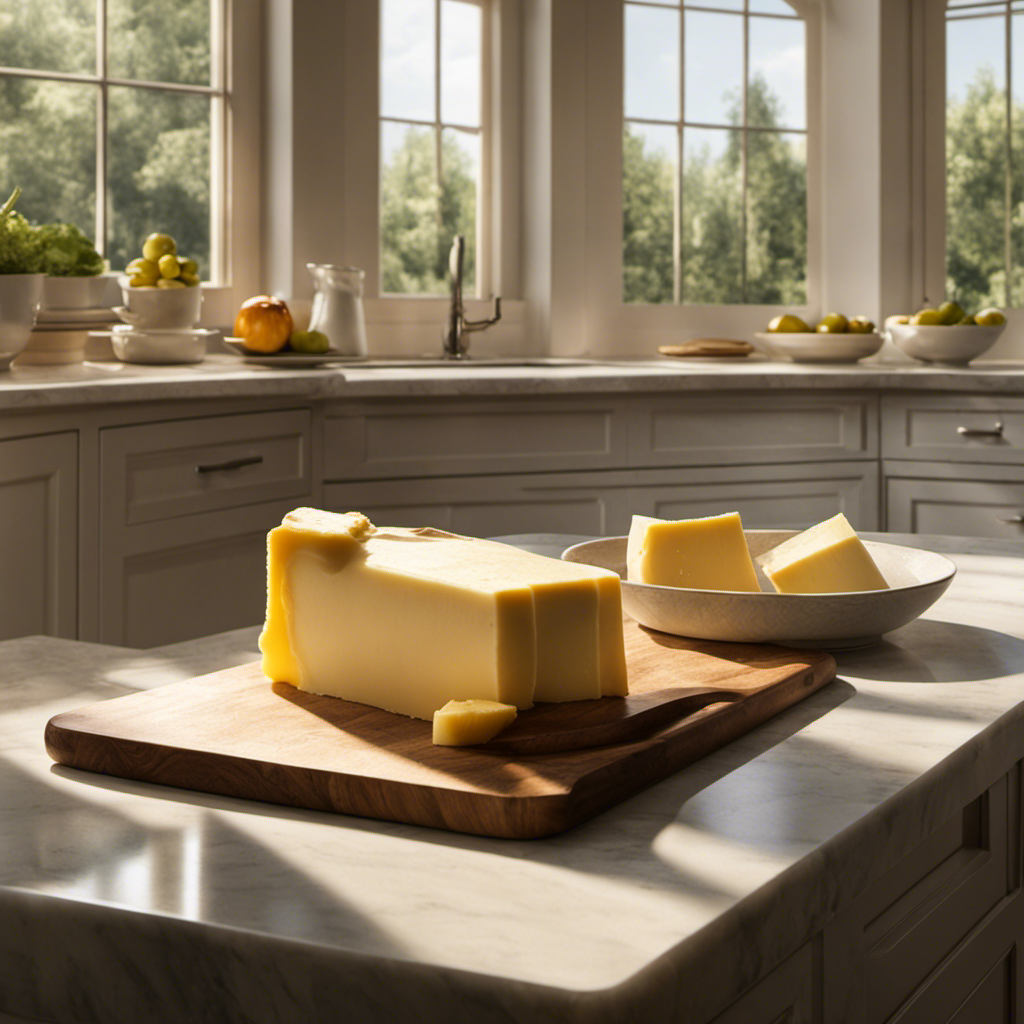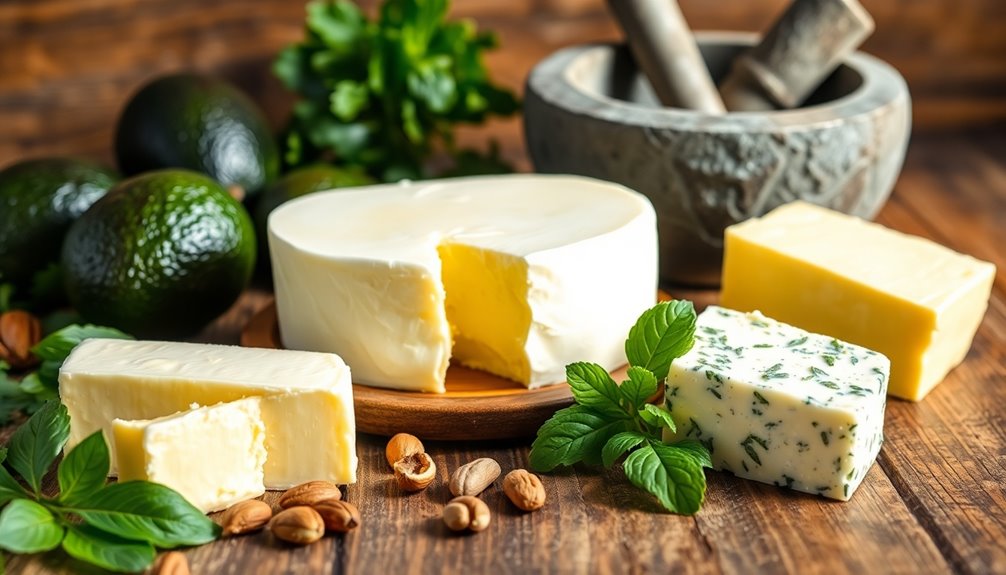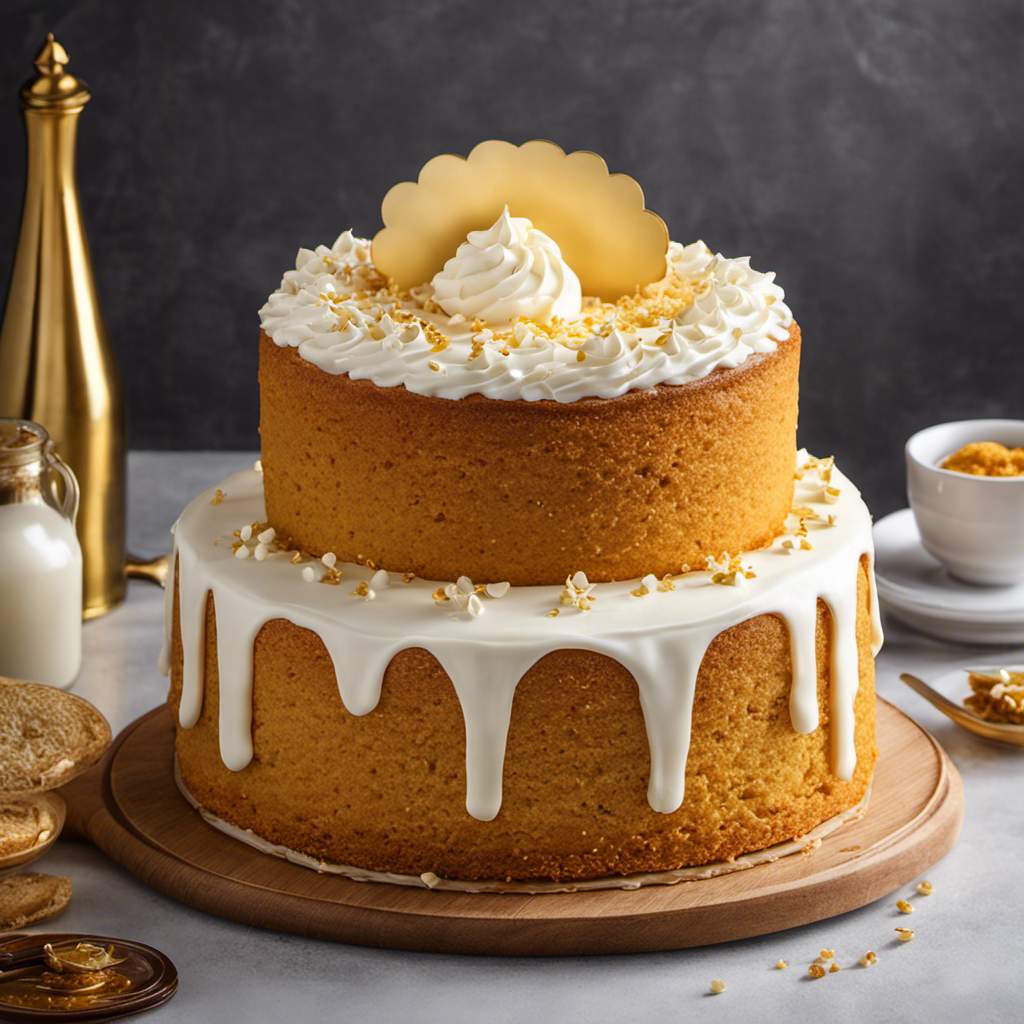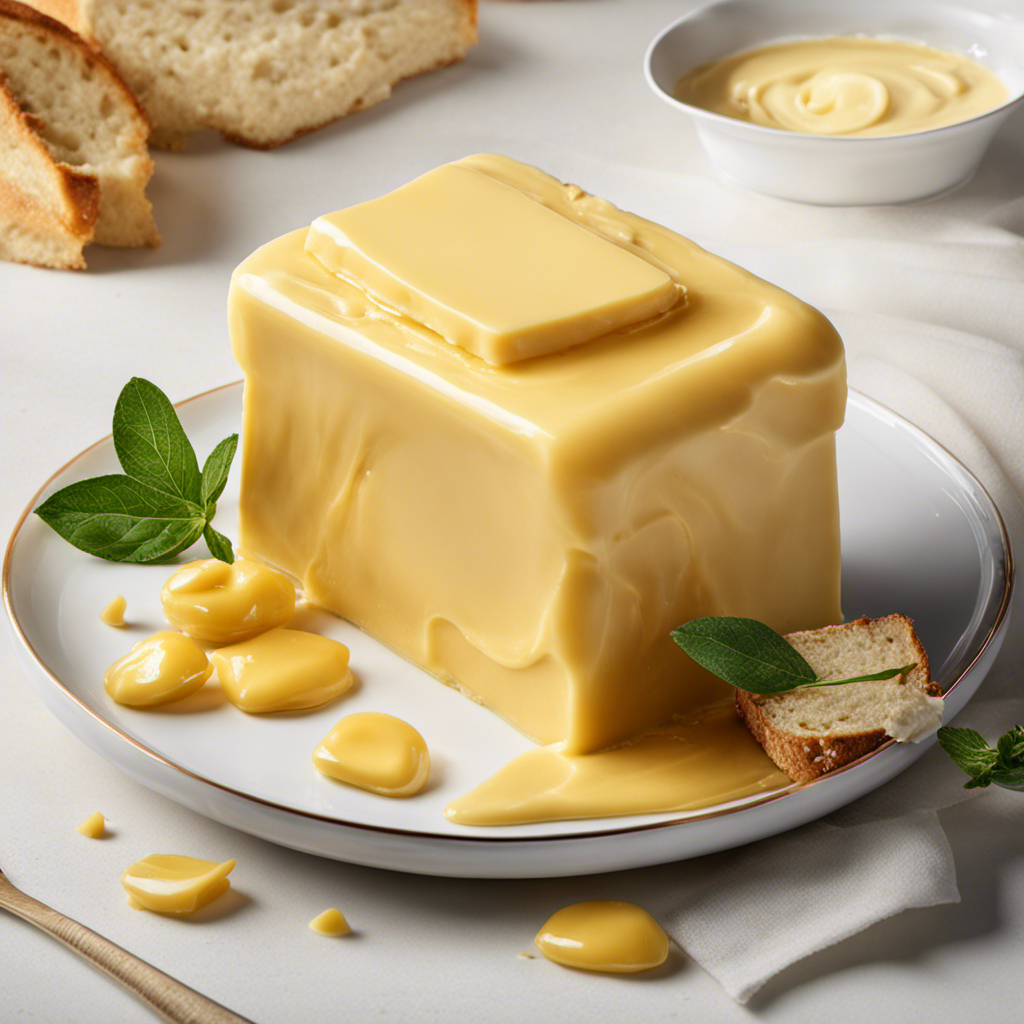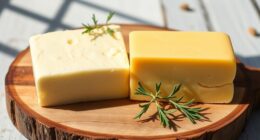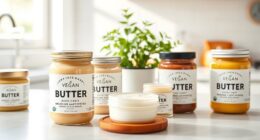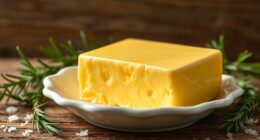I’ve always been intrigued by how long it takes for butter to reach room temperature. This seemingly minor detail can have a big impact on cooking and baking. That’s why I decided to do some research to understand the science behind it.
In this article, we’ll explore the factors that affect butter’s room temperature, the ideal temperature for butter, and how to use softened butter in recipes. Get ready to have perfectly softened butter every time!
Key Takeaways
- Room temperature butter can be achieved in 30 minutes to 1 hour by leaving it at room temperature.
- Other methods for softening butter include microwaving it in short intervals or grating cold butter.
- Factors such as temperature, humidity, and packaging can affect the speed of butter softening.
- Room temperature butter is beneficial for creaming, mixing, and incorporating ingredients, resulting in a lighter and fluffier texture in baked goods.
The Science Behind Butter Temperature
Butter needs time to soften at room temperature due to the chemical composition of its fats. When butter is cold, its fats are solid and tightly packed together, making it difficult to incorporate into pastry dough or buttercream.
However, as the butter warms up, the fats begin to melt and loosen, allowing for easier mixing and blending. This is important because the texture and taste of pastries can be greatly affected by the temperature of the butter used.
When making pastry dough, softened butter creates a tender and flaky texture, while cold butter creates a more crumbly and dense pastry. Similarly, in buttercream, using room temperature butter allows for a smoother and creamier frosting.
Factors Affecting Butter’s Room Temperature
Factors like time and environment impact how quickly butter reaches room temp. Understanding the factors affecting butter’s texture is essential for achieving the perfect consistency in baking and cooking. Here are three key factors to consider:
-
Temperature: Butter softens faster in warmer temperatures. Leaving it at room temperature for about 30 minutes should do the trick. However, in hotter climates, it may soften even faster, so keep an eye on it.
-
Humidity: The role of humidity in butter softening is significant. In high humidity environments, butter tends to soften more quickly due to the moisture in the air. On the other hand, in dry climates, it may take longer for butter to reach room temperature.
-
Packaging: The type of packaging can also affect butter’s softening time. Butter that is wrapped tightly in plastic wrap or stored in an airtight container will soften more slowly compared to butter left exposed to air.
Ideal Room Temperature for Butter
I’ve always wondered about the optimal softness of butter and the perfect timing for it to reach room temperature. It’s important to achieve the right consistency for spreading and baking, but how long does it actually take?
In this discussion, we’ll explore the ideal room temperature for butter and the factors that determine its softness at different time intervals.
Optimal Butter Softness
The optimal level of softness for butter can vary depending on personal preference. Some people prefer their butter to be soft and spreadable, while others prefer it to be firmer for baking purposes. Achieving the optimal butter consistency can be done through various butter softening methods.
Here are three methods to help you achieve the perfect softness for your butter:
-
Room Temperature Method: Leave the butter at room temperature for about 30 minutes to 1 hour until it becomes soft and easy to spread.
-
Microwave Method: Cut the butter into small pieces and microwave it for 5 to 10 seconds at a time, checking and stirring in between, until it reaches the desired softness.
-
Grating Method: Grate the cold butter using a cheese grater to achieve a soft texture that is perfect for baking.
Finding the optimal butter consistency is essential for different recipes and personal preferences.
Now let’s move on to discussing the timing for room temperature butter.
Timing for Room Temperature
To achieve the perfect softness for your butter, you can speed up the process by leaving it out of the fridge for about 30 minutes to 1 hour. This timing is optimal for bringing the butter to room temperature without it becoming too soft or melting.
It’s important to follow these best practices to ensure your butter is at the ideal consistency for baking or spreading. Leaving it out for less than 30 minutes may result in a still firm and cold center, while leaving it out for longer than an hour can cause the butter to become too soft and lose its structure.
Understanding Butter’s Solid-State
When discussing the solid-state of butter, it is important to consider its melting point and the factors that influence its solidification.
The melting point of butter is around 32 to 35 degrees Celsius, or 90 to 95 degrees Fahrenheit.
Factors such as temperature, composition, and processing methods can all affect the solidification process of butter.
Melting Point of Butter
Butter’s melting point varies depending on the type of butter and its composition. It is important to understand the melting point of butter in order to properly control its temperature and use it in various recipes. Here are three key points to consider:
-
Melting range: Butter’s melting point typically falls between 82°F (28°C) to 97°F (36°C). However, this can vary depending on factors such as the amount of water content and the presence of other ingredients.
-
Softening techniques: To bring butter to room temperature for baking or spreading, there are several techniques you can use. These include leaving it at room temperature for about 30 minutes, grating it, or using a microwave on low power.
-
Temperature control: When melting butter for cooking or baking, it is important to control the temperature to avoid burning or overheating. Using a low heat setting and stirring continuously can help prevent this.
Understanding the melting point of butter and implementing proper temperature control techniques can greatly enhance your culinary creations.
Factors Affecting Solidification
Controlling the amount of water content and other ingredients in my butter greatly affects how quickly it solidifies. The solidification of butter is primarily caused by the presence of water, which acts as a binder between the fat molecules. When the temperature drops, the water freezes and forms ice crystals, causing the butter to solidify. The higher the water content in the butter, the longer it takes for it to solidify.
On the other hand, room temperature plays an important role in butter solidification. At lower room temperatures, the butter solidifies faster due to the decreased heat energy in the surroundings. Conversely, at higher room temperatures, the butter takes longer to solidify as the heat energy from the surroundings slows down the solidification process.
Room Temperature Butter
When it comes to baking, room temperature butter is key. It allows for easier incorporation of ingredients and creates a lighter, fluffier texture in baked goods. But how can we ensure that our butter is at the right temperature?
Here are a few benefits of having room temperature butter and some tips for achieving it:
-
Enhanced creaming: Room temperature butter is easier to cream with sugar, creating a light and airy texture in cakes and cookies.
-
Improved mixing: When butter is at room temperature, it blends more evenly with other ingredients, resulting in a smoother batter or dough.
-
Quick softening: If you forgot to take your butter out of the fridge, you can soften it quickly by cutting it into small pieces or microwaving it in short intervals.
The Role of Fat in Butter Softening
The fat content in butter plays a significant role in how quickly it softens at room temperature. Butter is composed of both water and fat, with the fat content typically ranging from 80% to 82%. This fat gives butter its creamy and smooth texture, but it also affects its consistency when left at room temperature.
Higher fat content in butter means that it will soften more quickly, as fat has a lower melting point than water. So, butter with a higher fat content will become softer and more spreadable at room temperature faster than butter with a lower fat content.
This is why it is important to consider the fat content when choosing butter for specific recipes, as it can affect the texture and consistency of the final product.
Room Temperature Butter Vs Cold Butter
If you want spreadable butter, you should leave it out at room temperature for a while instead of keeping it cold. Room temperature butter has a soft and creamy texture that makes it easy to spread on bread or toast.
Here are three reasons why room temperature butter is preferable to cold butter:
-
Spreadability: When butter is at room temperature, it becomes soft and pliable, making it much easier to spread on various foods. Cold butter, on the other hand, is hard and can tear delicate baked goods.
-
Flavor: Butter stored in the fridge can develop off-flavors and lose some of its natural sweetness. Allowing it to come to room temperature allows the butter to retain its delicious flavor profile.
-
Baking: Many baking recipes call for room temperature butter as it blends more easily with other ingredients, resulting in a lighter and fluffier texture in cakes and cookies.
To soften butter quickly, you can cut it into small pieces or microwave it in short bursts. However, it’s important to note that leaving butter at room temperature for too long can cause it to spoil, so be mindful of how much you take out at a time.
Butter’s Softening Time in Different Environments
Now that we understand the difference between room temperature butter and cold butter, let’s talk about how to soften butter.
There are several methods you can use to soften butter, depending on how much time you have. One of the quickest ways is to use the microwave. Simply place the butter in a microwave-safe dish and heat it on low power for about 10-15 seconds. Be careful not to overheat it, as melted butter won’t work for all recipes.
If you don’t have a microwave, you can also leave the butter on the counter for about 30 minutes to an hour, depending on the temperature of your kitchen.
It’s important to note that softer butter will incorporate better into your recipes, so finding the right softening method is crucial.
Techniques to Speed up Butter Softening
One of the quickest ways to soften butter is by using the microwave. Here are three techniques to speed up butter softening using the microwave:
-
Cut the butter into smaller chunks: By cutting the butter into smaller pieces, you increase the surface area, allowing it to heat more evenly and soften faster in the microwave.
-
Use short bursts of low power: Instead of microwaving the butter at full power, use short bursts of low power (around 10-20% power) for 5-10 seconds at a time. This prevents the butter from melting or becoming too soft.
-
Rotate and flip the butter: To ensure even softening, rotate and flip the butter after each burst of microwaving. This helps distribute the heat evenly and prevents any parts from melting before others.
Common Mistakes in Softening Butter
To avoid common mistakes in softening butter, make sure you don’t microwave it for too long or on high power. Microwaving butter for too long can cause it to melt or become overly soft, which can affect the texture and consistency of your baked goods.
Another common mistake is using hot water to soften butter. While it may seem like a quick solution, it can lead to uneven softening and affect the butter’s emulsion.
Instead, try using room temperature butter or gently grating cold butter, which can help it soften more evenly and faster. Another technique to speed up butter softening is to cut it into smaller pieces or flatten it with a rolling pin. These methods increase the surface area, allowing the butter to come to room temperature more quickly.
Using Butter at Different Temperatures
If you want your baked goods to turn out perfectly, remember that using butter at different temperatures can significantly impact the texture and consistency of your final product.
Here are three key points to keep in mind when it comes to butter temperature for pastry and sautéing:
-
For pastry: When making pastries like pie crusts or croissants, it’s crucial to use cold butter. The cold butter helps create layers in the dough, resulting in a flaky and tender texture. To achieve this, cut the butter into small cubes and chill it in the refrigerator before incorporating it into the dough.
-
For sautéing: When sautéing or cooking on the stovetop, it’s best to use room temperature or slightly softened butter. This allows the butter to melt evenly and coat the ingredients, giving them a rich and flavorful taste. Softened butter also helps prevent burning or uneven cooking.
-
Remember to adjust your butter temperature according to the recipe you’re following. Some recipes may specifically mention using melted butter or softened butter, so be sure to follow the instructions to achieve the desired results.
Softened Butter in Baking Recipes
Remember, when you’re baking, it’s important to have softened butter for your recipes. The optimal butter consistency is key to achieving perfect butter softness, which allows for easier mixing and better incorporation of ingredients. But how long does it take for butter to get to room temperature? Well, it depends on the temperature of your kitchen and the initial temperature of the butter. Generally, it takes around 1 to 2 hours for butter to soften at room temperature. However, if you’re short on time, there are a few tricks you can use to speed up the process. Placing the butter in a microwave-safe bowl and heating it in short bursts, or grating the cold butter and spreading it out on a plate can help soften it more quickly. Just be careful not to melt the butter completely! Here’s a table to summarize the different methods and estimated times for softening butter:
| Method | Time Estimate |
|---|---|
| Room temperature | 1 to 2 hours |
| Microwave (short bursts) | 15 to 30 seconds |
| Grating and spreading | 10 to 15 minutes |
With these tips, you can ensure that your butter is at the perfect consistency for your baking adventures!
Storing Softened Butter Properly
When it comes to storing softened butter properly, there are a few key points to consider.
First, it’s important to know the different storage options available, such as using a butter dish or wrapping it in parchment paper.
Secondly, understanding the ideal room temperature for butter can help prevent spoilage and maintain its quality.
Lastly, implementing proper techniques to prevent contamination, such as keeping it away from strong odors or using a clean butter knife, is crucial for ensuring its freshness and taste.
Butter Storage Options
Storing butter at room temperature helps it soften faster for baking. When it comes to butter storage, it’s important to use the right containers and follow best practices to ensure freshness and prevent spoilage.
Here are three recommended options for storing butter:
-
Butter dish: A butter dish with a lid is a classic and convenient choice. It keeps the butter protected from air and contaminants while allowing easy access.
-
Butter crock: A butter crock, also known as a butter bell, is a popular choice for keeping butter at room temperature. It uses a water seal to create an airtight environment, keeping the butter fresh and spreadable.
-
Glass jar: A glass jar with a tight-fitting lid is another great option. It allows you to see the butter and easily monitor its freshness while providing a secure storage solution.
Ideal Room Temperature
When it comes to baking, room temperature butter is often necessary for achieving the perfect texture and consistency in your recipes. But what exactly is the ideal room temperature for butter? Well, the general consensus among bakers is that it should be around 65 to 67 degrees Fahrenheit (18 to 20 degrees Celsius). This temperature allows the butter to soften enough to be easily incorporated into your dough or batter, but not so much that it becomes too melty or greasy.
To achieve this ideal temperature, there are a few different techniques you can use to soften your butter. One popular method is to simply leave it out on the counter for about 30 minutes to an hour, depending on the temperature of your kitchen. Alternatively, you can place the butter in a microwave-safe bowl and heat it in short bursts of 5-10 seconds until it reaches the desired softness. Just be careful not to let it melt completely! Another option is to grate cold butter using a cheese grater, which helps it soften quickly and evenly.
Preventing Spoilage and Contamination
To prevent spoilage and contamination, make sure to properly seal and store your ingredients in airtight containers. This is especially important when it comes to perishable items like dairy products and raw meats.
Here are three things to keep in mind for preventing spoilage and maintaining food safety through temperature control:
-
Refrigeration: Store perishable items, such as milk, cheese, and meat, in the refrigerator at temperatures below 40°F (4°C). This slows down bacterial growth and extends the shelf life of these products.
-
Freezing: If you don’t plan to use certain ingredients immediately, freezing them can help prevent spoilage. Make sure to use freezer-safe containers or bags and label them with the date to ensure proper rotation.
-
Room temperature: Some ingredients, like dry goods and canned goods, can be safely stored at room temperature. However, it’s important to keep them in a cool, dry place away from direct sunlight and heat sources to prevent spoilage.
Butter Softening Alternatives
If you’re in a hurry, you can use alternative methods to soften butter quickly. There are several quick butter softening techniques that can help you achieve the desired consistency in no time.
One method is to grate the cold butter using a cheese grater. This increases the surface area of the butter, allowing it to soften faster.
Another option is to cut the butter into small chunks and place them in a microwave-safe bowl. Microwave the butter in short bursts of 5-10 seconds, checking and stirring in between, until it reaches room temperature.
Additionally, you can place the wrapped butter between two warm plates or use a warm water bath to speed up the softening process.
These butter softening methods are efficient and convenient when you’re short on time.
Frequently Asked Questions
Can I Microwave Butter to Soften It Quickly?
Microwaving butter is the fastest way to soften it, but it can also cause uneven melting or even melt it completely. I prefer leaving it on the countertop to gradually reach room temperature for better results.
Can I Leave Butter Out on the Countertop Overnight to Soften?
Leaving butter out on the countertop overnight is a common method to soften it quickly. However, there are alternative methods that can speed up the process even more.
Can I Use a Hairdryer to Soften Butter?
Using a hairdryer to soften butter can be an effective method, but it also has the potential to be a disaster. Butter needs to reach room temperature so it can be easily spreadable.
Can I Soften Butter in the Oven?
Yes, you can soften butter in the oven. Preheat the oven to the lowest temperature, wrap the butter in foil, and place it in the oven for a few minutes. Be careful not to melt it completely.
Can I Freeze Butter to Speed up the Softening Process?
Freezing butter can speed up the softening process. By placing butter in the freezer for about 30 minutes, it becomes firmer and easier to work with. This hack is a time-saving solution for recipes.
Conclusion
So there you have it, folks! After diving into the science and factors affecting butter’s room temperature, we have finally reached the end of our buttery journey.
We now know that butter takes approximately 30 minutes to soften at room temperature, unless you’re living in the Arctic Circle, in which case, good luck!
But fear not, for we have also learned about the ideal room temperature for butter and the role of fat in its softening process.
So go forth, armed with this newfound knowledge, and enjoy your perfectly softened butter. Bon appétit!
